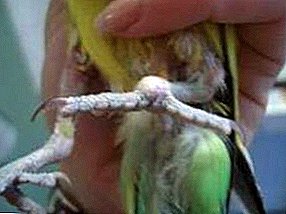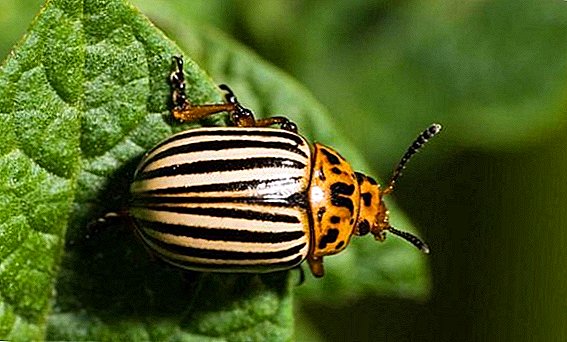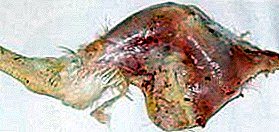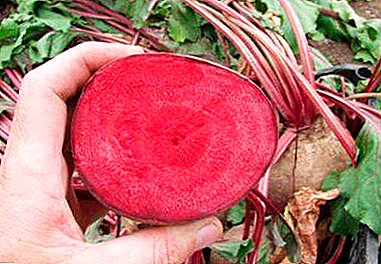
During the time when the chicken lays many eggs every day, it develops quickly enough and gives high-quality dietary meat in the shortest possible time it experiences quite strong loads.
As a result of such loads in the body of the chicken, some malfunctions can occur, precisely at the cellular level. They are quite a normal response to strong metabolic loads.
If the cells work properly, the internal organs start to hurt. This leads to various diseases capable of striking the intensity of the egg-laying. The most common disease is uric acid diathesis or gout.
Gout - a violation of metabolism (metabolism), in which there is an excessive accumulation of uric acid in the cells of chicken and urea salts in the tissues, its organs and blood.
Uric acid is the end product of nitrogen metabolism produced by the liver and excreted by the kidneys.
What is gout in chickens?
 Urea diathesis incurable disease. As a rule, about 10-15% of chickens are sick in poultry farms.
Urea diathesis incurable disease. As a rule, about 10-15% of chickens are sick in poultry farms.
In chickens, alas, uric acid diathesis is noticeable only in the last stages, so it is impossible to identify it at the onset of the disease.
It is not always possible to avoid it when such a large load is placed on chickens. This disease entails great economic losses to the poultry industry.
Not only chickens but also other birds suffer from gout. For example, turkeys, ducks, geese, pheasants, pigeons, parrots.
The disease has different names: urolithiasis, visceral gout, gout. All this is the same.
Pathogens
 The disease develops gradually due to the lack of necessary elements in the diet. To the greatest extent, it is a disadvantage vitamin a.
The disease develops gradually due to the lack of necessary elements in the diet. To the greatest extent, it is a disadvantage vitamin a.
Also, the aggravation of the situation affects deficiency of vitamins B6 and B12. In this regard, violations of the renal tubular epithelium begin.
As a rule, the disease manifests itself in laying hens at a rather adult age. But it happens that sick little chickens.
Uric acid diathesis can be in a dormant state and manifest itself under certain conditions.
For example, it can manifest itself by overcooling chickens, or by eating substandard food with harmful chemical impurities. Also, among the reasons are the lack of water for the birds, an excess of calcium in the feed and a lack of phosphorus.
Also, experts believe that the renal dysfunction can be caused by nephropathogenic serovariants of infectious bronchitis virus and nephritis enterovirus.
Current and main symptoms
 In the initial stage of the disease can not be detected.
In the initial stage of the disease can not be detected.
Already in the later stages, intestinal disorders, diarrhea, fecal pure white mass are observed, the egg production of sick chicken and hatching of eggs go down, there is a general deterioration of the condition.
If you do not notice the symptoms and do not start treatment, in order not to continue the development of the disease and the accumulation of ureas in the chicken's body, this can lead to sudden death.
In the body of the chicken is the accumulation of uric acid salts. It is deposited on the walls, on all internal organs.
Depending on the duration of the disease, they can be deposited in the form of a thin plaque, solid thick deposits or in the form of white islets.
In the ureters, you can observe a white, slimy mass, which contains salt and gradually form stones. Also, salt is deposited in and around joints, tendons.
Diagnostics
As a rule, it is not possible to correctly diagnose the disease during the hens' life Only after the death of the bird is it possible to determine the disease.
You can be sure that the chicken was sick with uric acid diathesis, if the detected plaque on the walls of the chest-abdominal cavity and on the internal organs are examined under a microscope.
Uric acid crystals have a long oblong shape, similar to a needle.
Treatment of uric acid diathesis
 It is absolutely impossible to cure urine-acid diathesis in birds, in particular, in chickens., since the body has already undergone irreversible processes.
It is absolutely impossible to cure urine-acid diathesis in birds, in particular, in chickens., since the body has already undergone irreversible processes.
But how the chicken will feel after taking some measures will depend only on the stage of the disease. In the later stages of treatment may not bring any effect.
Chickens should be drunk with a 2% aqueous solution of bicarbonate soda, a 0.5% solution of Carlsbad salt, 0.25% hexamine, 3% Novatofan.
In large farms, it is necessary to alkalize the feed with bicarbonate soda and feed the bird with such feed for two weeks, then take a break for a week, and feed again two weeks with feed that has been alkalized with bicarbonate soda.
Also, during the treatment period, it is necessary to normalize the nutrition of chickens, to calculate all the norms necessary for healthy poultry life.
In the diet should be a sufficient amount of protein, amino acids, vitamins and trace elements. In particular, you need to pay attention to vitamins A, B6 and B12. Also, you need to monitor the level of mycotoxins in the feed. If even a small part of them is detected, it is necessary to introduce binding powders. This may be, for example, silicone powders.
Prevention and precautions
To avoid uric acid diathesis, it is necessary to normalize the feeding of chickens. The composition of the feed should include all the necessary trace elements.
Also, you need to feed the bird only high-quality food that does not have in the composition of any mycotoxins or other harmful chemical impurities.
Also, having waited no more than eight hours after hatching, chickens can be treated with vitamin aerosols and glucose. Especially effective aerosols of vitamin C.
Different types of kidney disease
 Visceral gout characterized by the deposition of uric acid salts on the serous membranes of internal organs. Urate blockage of kidney tubules. Causes are protein overfeeding poisoning, infectious bronchitis of chickens, EDS '76.
Visceral gout characterized by the deposition of uric acid salts on the serous membranes of internal organs. Urate blockage of kidney tubules. Causes are protein overfeeding poisoning, infectious bronchitis of chickens, EDS '76.
Nephrosis characterized by swelling and an increase in the kidneys, necrosis of the epithelium of the kidney tubules. The reason is an excessively large amount of animal feed in the daily diet.
Glomerulonephritis characterized by a dysfunction of the glomerular membranes, deposition of hyaline in the tubules of the kidneys. The causes are aflotoksikoz B.
Pyelonephritis acute is characterized by an increase in the volume of the kidneys, interstitial edema on the pink background of the kidneys, a well-marked expansion of the tubules filled with urates. Causes are vitamin A deficiency.
Chronic pyelonephritis characterized by shrinking and decreasing in the volume of the kidneys. The causes of the disease are not yet precisely known.
Calcium Nephrology or urolithiasis is characterized by expansion of the ureters, stones in the lumen. Stones fall into the lumen of the ureters, which are connected with the wall. The buds become asymmetrical and large in volume. The reasons are the wrong amount in the diet of calcium and fluorine. In an adult bird, it awakens in case of poisoning.
 Bielefelder chickens with good production properties can also easily tolerate different climatic conditions.
Bielefelder chickens with good production properties can also easily tolerate different climatic conditions.Read all about bird levies here: //selo.guru/ptitsa/bolezni-ptitsa/pitanie/urovskaya.html.
Nephrosopathy in bred chickens, there is an increase in the kidneys in volume, by congestive processes in the lumen of the ureters. The reasons are improper nutrition, violation of diet, lack of vitamin A, mycotocosis.
Visceral gout embryos are characterized by the deposition of uric acid salts on the body of the embryo, in the yolk sac and in the kidneys. At the moment, they did not find out the exact causes of the disease, it is only known that it manifests itself in embryotoxicosis.
Chick Dehydration characterized by subcutaneous and intramuscular deposits of urats, dry muscles, kidneys, filled with urates. The causes are normal chicks at the hatchery and overexposure during transport.
 Diseases of urine diathesis chickens can be avoided if you follow all the precautions and take care of proper nutrition of chickens.
Diseases of urine diathesis chickens can be avoided if you follow all the precautions and take care of proper nutrition of chickens.
If several diseased chickens are detected, preventive measures should be taken for the entire chicken coop. After all, this suggests that you are doing something wrong.
It is necessary to review the care of the bird, or even seek the help of specialists in this area.
After all, no one wants to incur enormous damage, and it would be nice to get the maximum profit for both large farms and small domestic chicken coops.












